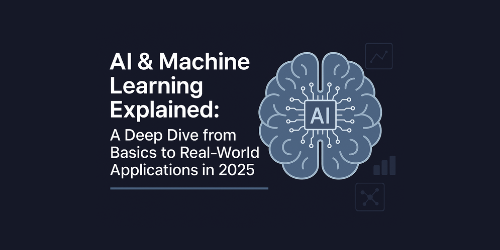AI & Machine Learning Explained: A Deep Dive from Basics to Real-World Applications in 2025

AI
ML
ai and big data
mlops introduction
Data Collection
Model Selection
Artificial Intelligence (AI) and Machine Learning (ML) have transitioned from science fiction to a practical reality, driving innovations in every field. AI/ML is reshaping how we interact with technology, from self-driving cars to voice assistants.
1. Introduction to AI and ML
Artificial Intelligence (AI) and Machine Learning (ML) have transitioned from science fiction to a practical reality, driving innovations in every field. AI/ML is reshaping how we interact with technology, from self-driving cars to voice assistants.
Example: When you use Google Maps and it suggests the fastest route by analyzing traffic patterns, that’s AI. When Netflix recommends a movie you might like based on your watching habits, that's ML in action.
2. Understanding the Core Concepts
2.1 What is Artificial Intelligence (AI)?
AI refers to the simulation of human intelligence in machines that are designed to think and learn like humans.
Types of AI:
- Narrow AI: AI systems designed for a specific task (e.g., Alexa).
- General AI: Hypothetical AI that can perform any intellectual task a human can do.
- Super AI: Theoretical AI surpassing human intelligence.
2.2 What is Machine Learning (ML)?
ML is a subset of AI that allows systems to learn from data without explicitly being programmed.
Types of ML:
- Supervised Learning: Algorithms learn from labeled data.
- Example: Predicting house prices based on size and location.
- Unsupervised Learning: Algorithms find hidden patterns in unlabeled data.
- Example: Customer segmentation for marketing.
- Reinforcement Learning: Algorithms learn from trial and error.
- Example: Training a robot to walk by rewarding successful steps.
3. Deep Learning: A Subset of ML
Deep Learning uses neural networks with multiple layers to model complex patterns.
Example: Facial recognition apps like FaceID use Convolutional Neural Networks (CNNs) to detect and analyze facial features.
Components of Deep Learning:
- Input layer
- Hidden layers (with activation functions like ReLU)
- Output layer
Use cases:
- Language translation (Google Translate)
- Medical image analysis (tumor detection)
- Self-driving cars (object detection)
4. How AI/ML Works
Step-by-Step Workflow:
- Data Collection: Gather data from various sources.
- Example: Customer purchase records.
- Data Cleaning: Handle missing values, remove duplicates.
- Feature Engineering: Extract useful variables from raw data.
- Example: Converting dates to time of day.
- Model Selection: Choose algorithms like decision trees or neural networks.
- Model Training: Feed data to the model to learn patterns.
- Evaluation: Test accuracy using metrics like RMSE or F1 score.
- Deployment: Use APIs or apps to serve the model to users.
5. Key Algorithms and Use Cases
| Algorithm | Description | Real-World Use Case |
|---|---|---|
| Linear Regression | Predict numeric values | Predicting housing prices |
| Logistic Regression | Classification algorithm | Email spam detection |
| Decision Tree | Tree-like structure for decisions | Loan approval prediction |
| K-Means Clustering | Grouping similar data | Customer segmentation |
| Naïve Bayes | Probability-based classification | Sentiment analysis |
| CNN (Convolutional NN) | Image processing | Face detection on smartphones |
| RNN (Recurrent NN) | Sequence data analysis | Stock price forecasting |
| Transformer | Processes sequence data in parallel | ChatGPT, BERT for text generation |
6. Popular Libraries and Tools
- Languages: Python, R
- Libraries:
- Scikit-learn: Ideal for classical ML algorithms.
- TensorFlow: Google's open-source deep learning framework.
- PyTorch: Facebook's flexible deep learning platform.
- Keras: High-level API for TensorFlow.
- HuggingFace: NLP transformer models like BERT, GPT.
- Tools:
- Jupyter Notebook: Interactive coding and visualization.
- Google Colab: Free GPU-powered notebooks.
- MLflow: Track experiments and models.
7. How to Start with AI/ML
Beginner Roadmap:
- Learn Python and libraries like Pandas, NumPy.
- Study math foundations: Statistics, Linear Algebra.
- Take free courses (e.g., Andrew Ng’s ML on Coursera).
Example project: Build a spam classifier using Naïve Bayes.
Intermediate Roadmap:
- Implement supervised models using Scikit-learn.
- Try real-world datasets (e.g., Titanic, MNIST).
- Learn how to split datasets and validate models.
Example project: Image classifier using CNN in TensorFlow.
Advanced Roadmap:
- Use Docker & Kubernetes for deployment.
- Master MLOps and CI/CD for ML.
- Study research papers (e.g., "Attention is All You Need").
Example project: Build and deploy a chatbot using HuggingFace Transformers.
8. Ethical Considerations in AI
Common Issues:
- Bias: Trained on unrepresentative data.
- Example: Facial recognition misidentifies people of color.
- Privacy: Misuse of personal data.
- Example: Predictive policing tools.
- Transparency: Explainability of decisions.
Regulations:
- GDPR (Europe)
- AI Act (EU 2025)
9. Real-World Applications in 2025
- Healthcare:
- AI for early cancer detection
- Wearable devices predicting heart attacks
- Finance:
- AI for fraud detection and customer scoring
- Robo-advisors for investing
- Retail:
- Personalized product recommendations
- Smart inventory systems
- Transportation:
- AI in traffic prediction and autonomous driving
- Education:
- AI tutors provide personalized learning plans
10. Future Trends in AI/ML
- Generative AI: DALL·E for image generation, Sora for video.
- Explainable AI (XAI): Tools to make AI decisions understandable.
- Edge AI: AI running on local devices.
- Multimodal AI: Combining text, audio, and image input.
- AI in Cybersecurity: Predicting and responding to threats in real-time.
Conclusion
AI and ML are not just technologies; they're the foundation of the future.
Whether you're building applications, studying for a career, or managing products, understanding these concepts deeply is no longer optional.
Take the step. Learn the math. Build the model. Shape the future.
